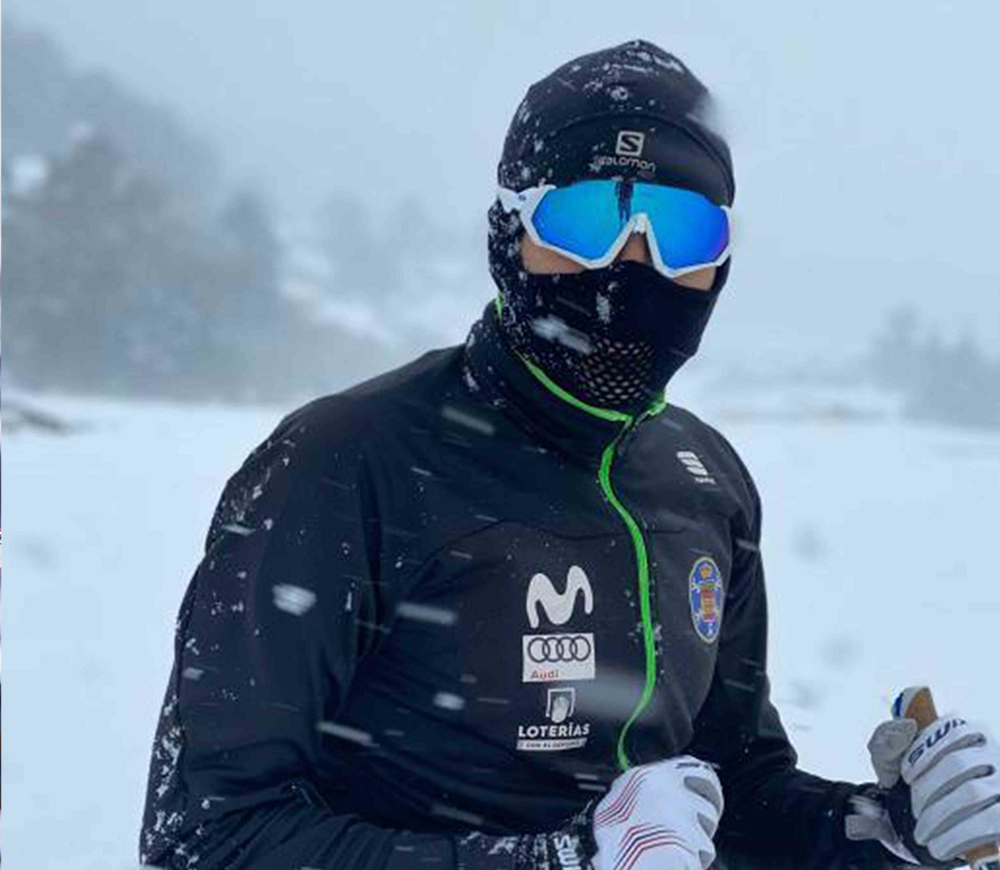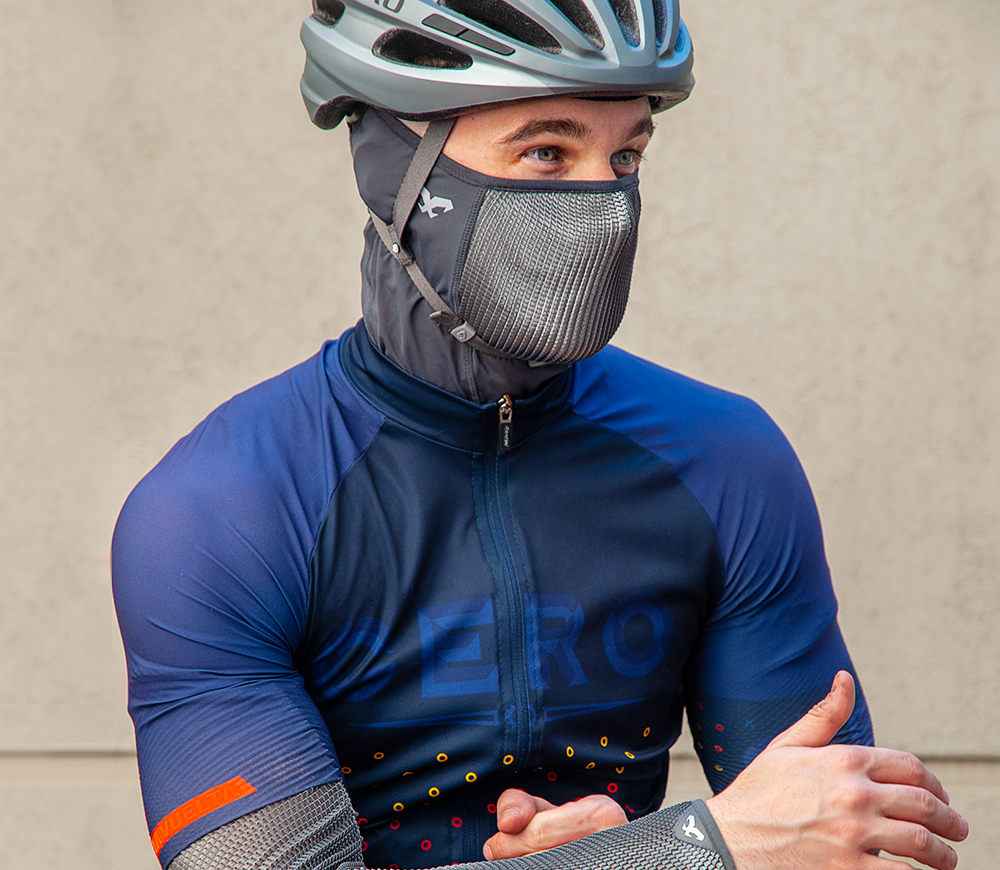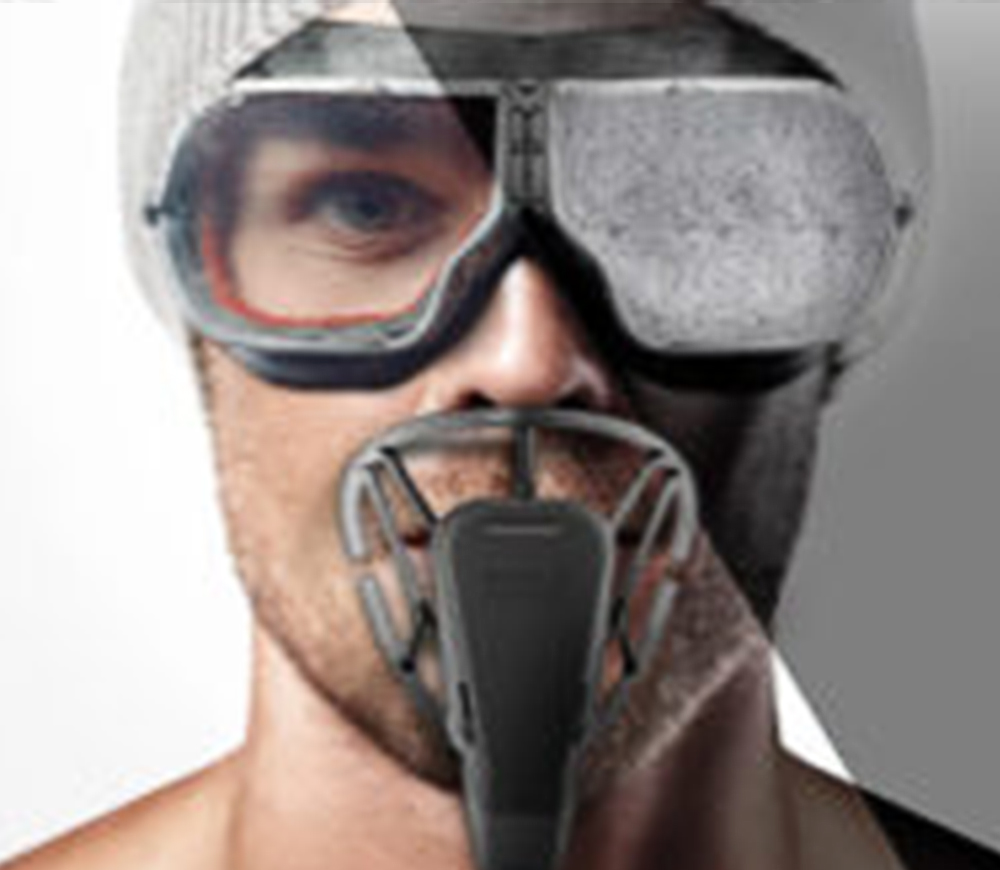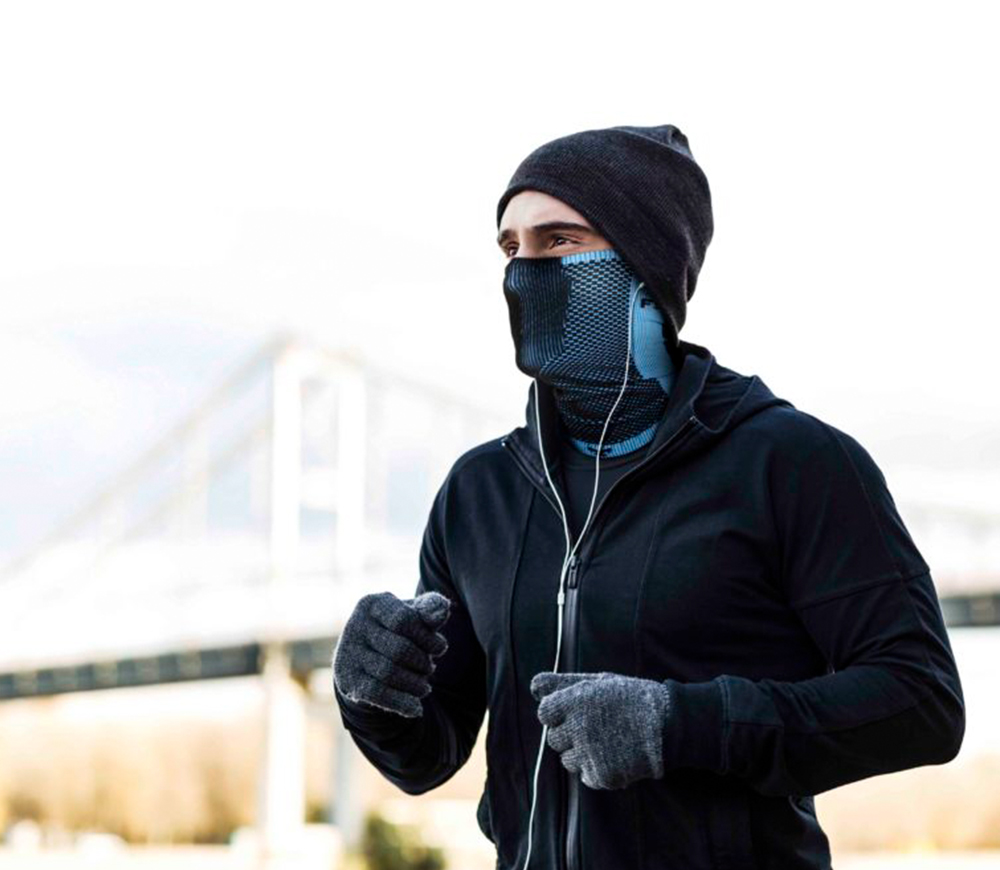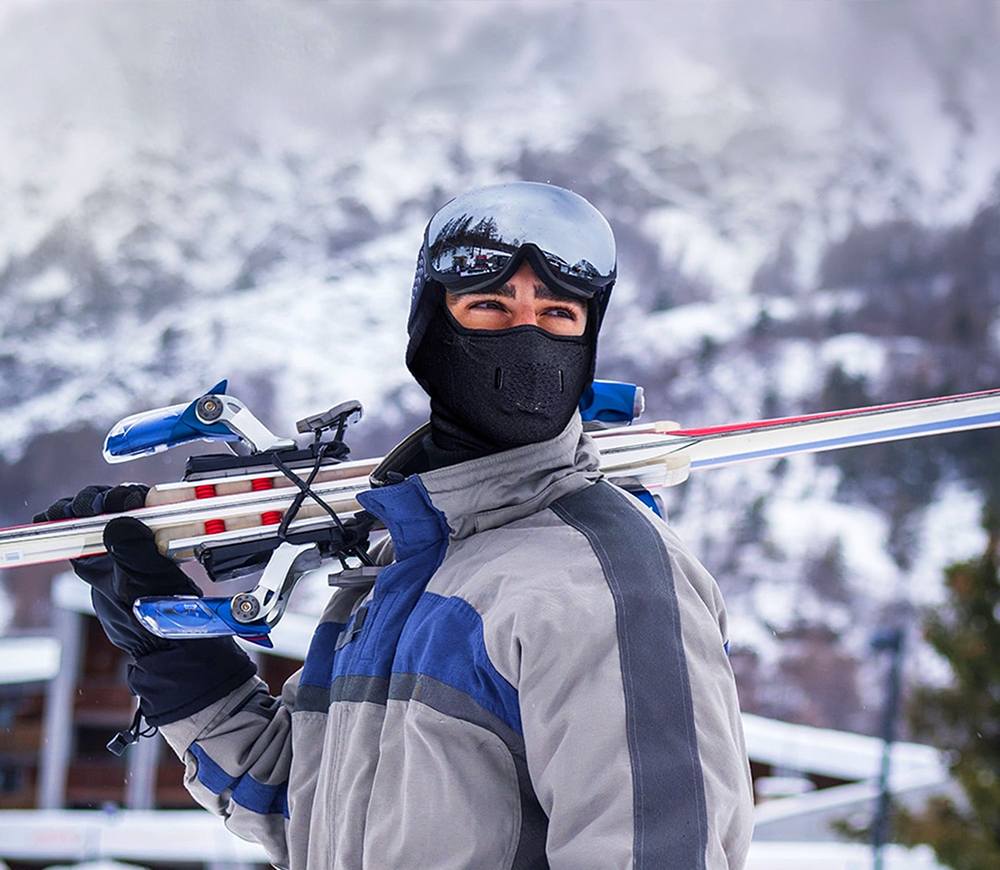Say goodbye to uncomfortable moisture this winter!Dashing through the snow, on a pair of super skis~Down the hills we go, huffing all the way~Condensation forms, soaking all our masks~What a horrible time to ski and feel cold moisture on our necks!Oh! Soggy masks. Soggy masks!As we venture into the colder months of the year, we have the snow and winter sports to look forward to. But, we also have the problems that come with trying to stay warm as we enjoy the cold. One of the biggest ones is the one described in our holiday time play on “Jingle Bells,” “Soggy Masks.” We know we have to keep our airways warm so that we can breathe and exercise properly. We put scarves and masks and gaitors and neck warmers on to try and tackle these problems, but we’re normally left with wetness around our mouths, noses, cheeks, necks, and sometimes even ears and heads!Our wintertime and holiday time solution to avoid the most uncomfortable situation when exercising in cold weather is to wear something specifically designed to tackle our wintertime woes: a good winter mask.That’s where NAROO steps in. We plan, test, and design our masks to take care of athlete’s safety and comfort. Wearing wet clothes in freezing temperatures stresses not just our minds but harms our bodies as well, causing us discomfort and potentially weeks of colds and recovering with tea and blankets afterwards. Tea and blankets are nice, but not when we could be outdoors!We design our masks with moisture-wicking fabric. In laymen’s terms, that means that the fabric is quick dry. The condensation from our humid breathing and sweat is absorbed by the first layer of the mask, and then moved through to the top layer for a quick evaporation process, keeping us nice and dry. We should be mindful of the most important features of masks needed to exercise in winter: Insulating – it keeps us warmEasy breathing – we won’t struggle to breatheQuick dry – moisture quickly evaporatesWashable – good for many usesComfortable – pairs nicely with wintertime gear like helmets, googles, and hatsDoes not slip – the mask stays in place with customizable fabric and bendable partsProtects against UV radiation – protects UV glare from snow or directly from the sunMoisture-wicking fabric – fabric made to enable the quick dry to keep you dry as you goNOT absorbing – moisture is not absorbed, it is quickly evaporated A mask needs to be washable for serious sportspeople who want to be up the mountain or outdoors every day. We’re not just one-day skiers, snowboarders, and athletes – if we do winter sports, we do it seriously. As we sweat, it’s important to pay attention to hygiene, to avoid unpleasant odors, and avoid feeling sticky. NAROO’s moisture-wicking fabric moves moisture from your skin to the surface of the mask so it can evaporate. Wash your mask, and wear it the next day, and it will give you the same comfortable and easy breathing features, just like yesterday and the day before. Amazingly, our masks can be washed hundreds of times and retain the same filtering, moisture-wicking qualities as the first time worn.So grab a great wintertime mask and head out to enjoy the wintertime and your favorite sports.Take a look out our products, developed to keep you dry and happy this winter.
What’s the Difference Between a Sports Face Shield and a Workout Face Shield? From defense to disease prevention, masks are one of the most commonly used products today. Sports, in particular, require frequent usage of masks for a multitude of reasons. Be it for managing uncomfortable weather conditions, protecting the face from injury or just breathing less polluted air, masks have always been the answer. However, amateur sports enthusiasts may often confuse sports masks with a workout face shield, or vice-versa. Since each category of masks is manufactured to meet a specific purpose, anyone taking sports seriously needs to know the difference. Donning the wrong mask at the wrong time for the wrong reason can cause injury, discomfort, inconvenience, and compromised performance. So, let’s start with the obvious questions. Workout Face Shield? Essentially, training masks (also known as altitude masks or elevation training masks) are used to simulate high altitude conditions by stressing the body while exercising in lower altitudes. It is used to make breathing as hard as it would be in higher altitudes, so as to prepare the wearer for an environment in which breathing would be more difficult for them. Training masks limit the amount of air the wearer can inhale. Through repeated usage while training, it strengthens respiratory muscles by making them work harder. It helps accelerate physical performance, improve endurance, and prepare the body to function optimally in challenging respiratory conditions. View this post on Instagram A post shared by NAROO MASK | Official (@naroomask_global) What are Sports Face Shields? Sports Face Shields are specifically designed to handle sports activities. They are primarily meant to protect the wearer’s respiratory system from environmental factors while in the midst of strenuous activity. For example, a sports mask can be useful when you are running in a city with high smog levels, as it would protect you from inhaling polluted particles from the air and protect your lungs from too much damage as you inhale more oxygen more frequently during exercise. Of course, sports masks come in multiple variants to help protect the body while performing different activities or while operating in diverse environments. A few of these include: • Balaclavas: Headgear designed to cover most of the face, except the eyes and mouth. It is especially useful while motorcycling or engaging in winter sports, especially in snow climes. Their most basic functions are to protect from the wind, cold, and dust. Face masks/Face Covers: Masks or facial covers are equipped with filters that prevent the wearer from breathing in pollutants, pollen, or dust particles. These are useful when athletes have to train or perform in dusty locations or areas with high levels of pollution. Of course, there are also masks without filters that are made to provide protection from elements such as UV rays, strongs winds, jarring cold, flying insects, etc.Tubular masks/neck gaiters: Often made of materials meant to provide warmth (fleece, wool, etc.), it is shaped as a closed tube that one can slip over the head. This face covering also protects the neck, and can be pulled over the mouth and nose to protect against wind, debris, fumes, and other irritants.Driven by a desire to help athletes and sports enthusiasts deliver optimal performance, NAROO provides a catalogue of industry-best sports masks. We offer a variety of sports masks (running masks, cycling masks, masks for winter sports, and more) , each designed to align with the requirements of specific sports, weather conditions and the athlete’s performance level. For us, comfort, breathability and protection are the priority. Sport masks vs. Training masks – How are They Different? Simply put, one protects while the other strengthens. Sports masks are worn to ensure that the wearer does not inhale undesirable elements (fine dust, pollutants, insects, pollen, etc.). It is also meant to protect much of the face, including nose and mouth from inhospitable weather (cold temperature, strong wind, harsh sun, etc.). On the other hand, training masks restrict air flow to the wearer’s nose and lungs. This is done to strengthen their respiratory system by making it work harder in stressful conditions. Primarily, training masks are used to simulate high-altitude breathing conditions while training in lower altitudes. Since there is less oxygen and breathing naturally becomes more laboured when higher up, a training mask is a great way to acclimatize the body to these conditions without actually having to go to those heights. This is especially useful when preparing for strenuous treks or other physically challenging activities in challenging mountainous terrain. Benefits of Sports Masks Protect your airways: The right sports mask will make breathing infinitely easier during physical exertion than other face covers. While training, breathing quickens and you wouldn’t be able to consciously focus on avoiding dust or insects. But a mask equipped with filters can take care of that. It prevents dust, pollen, sand, bugs, and much more from being inhaled and tainting the airways and lungs. Enables greater focus: With breathing woes in control, the athlete can focus on nothing but their performance. They won’t have to deal with irritants like smog and dust. Additionally, adequately equipped masks will keep them wealthier in the long run, by preventing the inhalation of undesirable air particles. Protect your skin: Between UV rays and airborne irritants, your skin is exposed to a lot while you exercise. A great sports mask that protects your airways will also protect your skin from the same irritants. View this post on Instagram A post shared by NAROO MASK | Official (@naroo_global) Homemade Solutions – How Effective are They? Many athletes choose to wear a scarf, neck warmer, face bandana, balaclava mask or ski mask around their mouth and nose when training in the cold. However, while this does trap the warm, moist air they exhale, these items are quite uncomfortable, especially during intensive training sessions. Additionally, goggles get fogged up, causing visibility issues hence cutting down on performance capability. They are also not easy to breathe through, adding further deterrents to performance. NAROO’s breathable sports masks have been inspected and certified
Blisteringly cold winds, frost, dry thin air… These are less than inviting conditions for cold weather exercises. Cold weather exercises in winter always requires that little bit of extra willpower and motivation, especially when coming from a toasty warm bed or the coziness of your home.You could just go to the gym or stay at home and work out in the living room. But we all know that isn’t quite the same as getting out and enjoying the outdoors. Nothing can replace the thrill of forging your own path. Besides, there are benefits to outdoor physical activity, especially during winter. With the right preparation and equipment, cold weather exercising can be extremely mentally and physically rewarding, motivating you to get out of the house.However, winter isn’t always the friendliest time to exercise, and we should head out with caution and protection. We got you covered. Follow these steps and exercise comfortably in winter. 5 Tips for Protecting Your Lungs in Cold Weather Wash your hands frequently.Bacteria spread through the mucous membranes of the eyes, nose, and mouth. If the virus is on our hands and touching our faces, we are almost certain to get sick for a day or two at the office.Cover your nose and mouth with a neck warmer or sports mask when you go out in the cold.Cold air is often dry air and can irritate the airways in people with asthma, COPD, or bronchitis. This can cause wheezing, coughing and shortness of breath. Check Winter Face Coverings here.You have to cover your airways. Why? Because breathing in wintertime can be excruciating. Cold air entering our throats and lungs can burn and make it hard to continue. As the single most important key to successful exercise (in any season) is breathing, anything that prevents effective breathing has to be dealt with. The frigid air can cause asthma-like symptoms in any athlete, no matter how healthy they are.Here’s why you feel the burn in winter.When cold, dry air enters your airways as you breathe quickly during cold weather exercises, your trachea begins to dry out and tighten, which causes shortness of breath and discomfort. The longer you breathe cold air, the more you will feel your chest tighten. Also, your body will begin to function less efficiently due to oxygen deprivation.To avoid burning airways, the air you inhale must be warmed. Your respiratory system delivers its optimum performance when the air you inhale is heated and humidified before it enters the lungs. However, the only way to do this is to cover your airways, which can be uncomfortable and even hinder breathing.Wearing a comfortable, functional mask that covers your nose and mouth is key to ensuring warm air enters your system. To further help prevent feeling the effects of the cold, also cover your ears and neck.Dress warm and stay dry.A cold actually makes you more susceptible to pneumonia and other respiratory infections.We talked about breathing in through the nose, warming the air, and preventing the burn. But the other side of the breathing coin is breathing out, the exhale. In wintertime and while wearing a face covering, this poses its own set of problems. While we exercise, we breathe faster and that speed combined with a mouth covering can lead to moisture building inside scarves or masks. Many sportspeople complain about wet masks making their necks and faces cold. This can lead to the moisture freezing and becoming unbearable.In order to make exhaling as comfortable as possible, NAROO MASK fabric has been designed to allow moisture to disperse quickly even in sub-zero temperatures, instead of absorbing moisture like other materials. This is called a moisture-wicking system that helps you stay dry in the freezing cold. NAROO will help you breathe easily and stay warm and dry.Be careful with the wood burning fireplace and stay hydrated.While it may seem like a great way to warm up, smoke and fumes from fireplaces can be irritating for people with asthma, allergies, and other lung ailments.It is especially important to stay hydrated in winter because it may feel like you’re not thirsty and not sweating. But your body is in just as much need of water as in every other season. Drink at least 30 minutes before you head out and if you’re going far, bring some with you to stay hydrated along the way. Dehydration can make your body struggle, which includes your airways. Prevent any undue difficulty by drinking enough.If you have asthma or COPD, always keep your inhaler nearby.If you have trouble breathing, stop working immediately and use your inhaler as usual.
The Best Face Masks For Running Outside For 2023 We exercise to stay healthy. All year round, we head outdoors to work out. But in the winter, conditions are especially challenging. Not only is it uncomfortable to exercise in the cold, but it can be downright painful. Without a solution, freezing conditions can harm our health and chip away at our willingness to head outdoors to exercise. Let’s examine why exercising in winter poses a challenge and then tackle that challenge head on. What happens when we exercise in the cold? When we exercise in the cold, the struggle of our respiratory system (and subsequently other systems) can diminish our performance. How does this happen? Our vital capacity is significantly reduced, which means that the maximum amount of air expelled from the lungs after maximum inhalation is reduced. Our bronchial tubes, lungs, and mucous membranes become irritated and often dehydrated. Simply, they don’t like cold air. Our respiratory systems tighten and struggle to warm cold air causing asthma-like symptoms. Not only do casual athletes suffer from these cold weather breathing symptoms. Professional athletes struggle as well. During the Winter Olympics, many athletes report having respiratory problems. 50% of cross-country athletes and 43% of short-track speed skaters have experienced exercise-induced asthma. Why does all that happen when we exercise in the cold? Our respiratory systems like warm, most air. When we breathe in, our nose and bronchial tubes naturally warm and moisten the air before it enters our lungs. However, while exercising in the cold, our bodies are unable to efficiently warm and humidify the constant onslaught of cold, dry air. As a result, our airways narrow and consequently, our breathing capacity is limited. This is not ideal for any athlete and begs the question: If we want to go out and exercise, run marathons, or maintain our physiques in winter, how can we do it safely and healthily? Should we just exercise indoors? We could, but… If you don’t want to be limited to indoor activity, read on. Only one solution to wintertime breathing struggles is to head inside. Snow Face Mask Winter Sports Face Masks Solution: A Winter Sports Outdoors Warm Air Mask Studies have shown that exercising in cold environments can have a positive effect on our endurance, calories burn, and wintertime vitamin D intake. Plus, getting outdoors is liberating. When our airways are properly protected, continued outdoor activity isn’t a problem. So how do we take advantage of wintertime exercise benefits and avoid respiratory problems? An easy-breathing mask. A mask that keeps us comfortable and warm while controlling moisture. This mask also is integrated with unique fabric and internal ventilation mechanisms. A mask like this will help warm the air, maintain the required humidity, and also keep your face, neck, and head warm, allowing the warming process of the air to be performed more efficiently.We at NAROO Mask have developed a mask that can provide all these necessary breathing tools. A sports mask to protect athletes and sportspeople from cold air and wind, helping us focus on performance. NAROO winter masks are specifically developed to warm the air before it enters the respiratory system while also keeping us dry and comfortable while exercising. Check out our line of masks perfect for facing the cold. Choose a mask depending on your sporting needs. Whether you’re a runner with asthma, or a skier who spends your days in the snow, there is a mask for you. We recommend the N9H, Z9H, Z5H, X5, and F3H models for the winter season. See you out there. Select options Z5H – Breathable Anti-Fog Half- Balaclava with Built-in 3D Air-Room Rated 4.75 out of 5 based on 12 customer ratings 60.00 USD Select options Z9H – Anti-Fog Zip-up Half-Balaclava with Built-in 3D Air-Room Rated 4.33 out of 5 based on 3 customer ratings 95.00 USD Stock Out Select options T-BONE5+ Futuristic Windproof Sports Neck Gaiter with Built-in 3D Air-Room Rated 5.00 out of 5 based on 3 customer ratings 65.00 USD Select options EX-HALE – Anti-Fog Ventilation Module for Z9H Rated 3.50 out of 5 based on 2 customer ratings 25.00 USD Stock Out Select options R5 – Insect Protection Anti-Fog Sports Face Cover Rated 4.00 out of 5 based on 1 customer rating 80.00 USD Select options X5H – Breathable Windproof Half-Balaclava Rated 5.00 out of 5 based on 4 customer ratings 18.00 USD Select options X5s – Breathable Multifunctional Sports Face Mask Rated 4.65 out of 5 based on 17 customer ratings 15.00 USD Select options X5 – 2-in-1 Reversible Breathable Windproof Neck Gaiter Rated 3.50 out of 5 based on 4 customer ratings 20.00 USD Stock Out Select options X3F – Lightweight Breathable Military Balaclava Rated 5.00 out of 5 based on 2 customer ratings 37.00 USD Select options X1 – Breathable Thin Quick-Drying Neck Gaiter with Ear Loops Rated 5.00 out of 5 based on 2 customer ratings 20.00 USD

